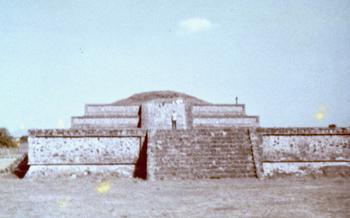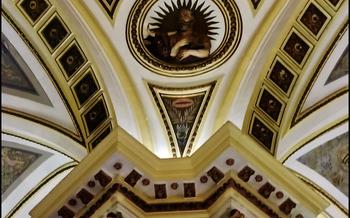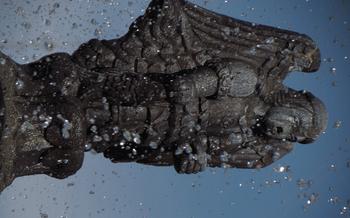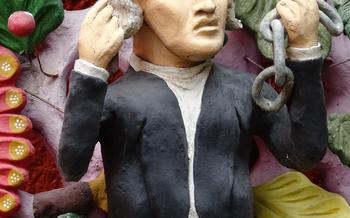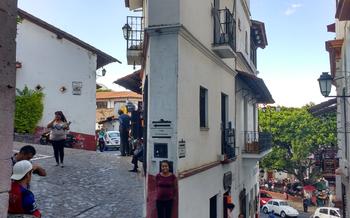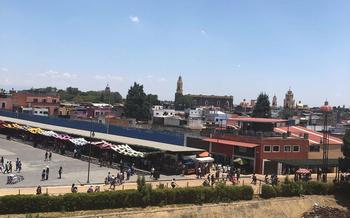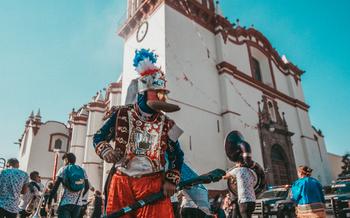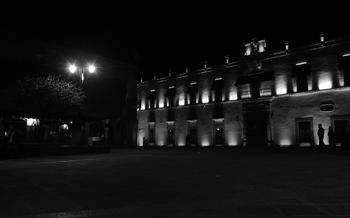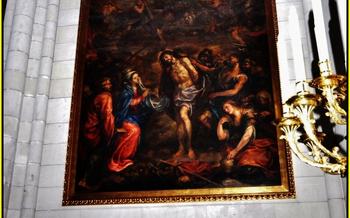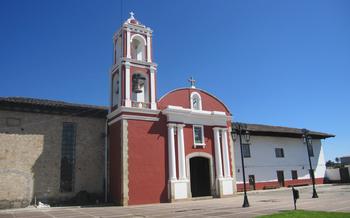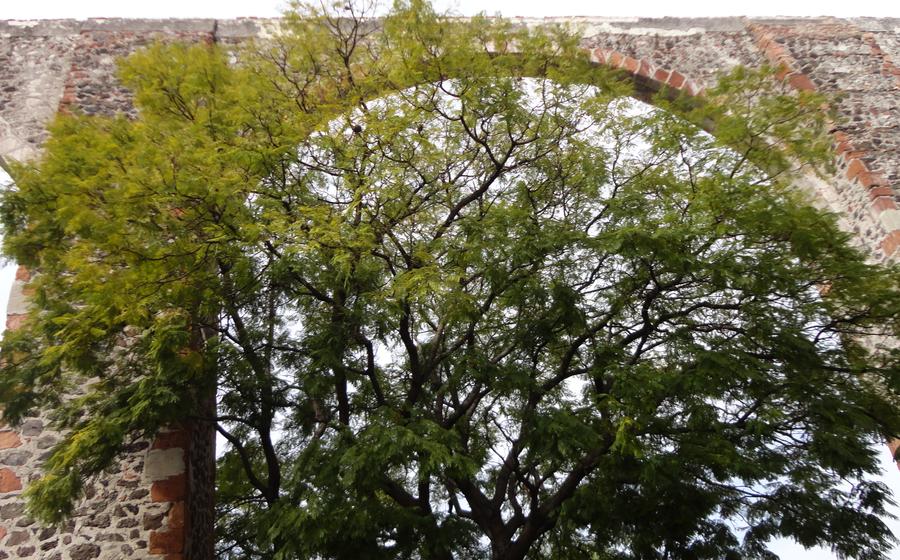
Museum of Handcrafts
- Historical Background
- Museum Highlights
- Types of Handcrafts
- Cultural Importance
- Interactive Experiences
- Historical Context
- Local Artisans
- Shopping Opportunities
- Educational Programs
- Events and Workshops
- Location and Accessibility
- Hours of Operation and Admission Fees
- Photography and Videography
- Accessibility for Visitors with Disabilities
- Insider Tip
Historical Background
In the heart of Mexico, nestled amidst the vibrant city of Queretaro, lies a treasure trove of traditional artistry and cultural heritage. The Museum of Handcrafts, a testament to the city's rich history, invites visitors to embark on a journey through the exquisite world of Mexican handcrafts. With its sprawling collection of intricately crafted pottery, vibrant textiles, and gleaming metalwork, the museum stands as a guardian of Queretaro's cultural identity. Step into this haven of artistry and discover the stories of skilled artisans, whose passion and dedication have shaped the cultural tapestry of this enchanting city.
Museum Highlights
The Museum of Handcrafts is a treasure trove of Mexican artistry, showcasing a diverse collection of traditional handcrafts from across the country. Visitors are immediately drawn to the grand entrance, which features a stunning display of colorful hand-painted tiles. The museum is divided into several sections, each dedicated to a different type of craft, allowing visitors to explore the intricacies and uniqueness of each art form.
At the heart of the museum, you'll find the pottery section, home to an impressive collection of hand-painted ceramics, including the iconic Talavera pottery from Puebla. The textiles section boasts an array of vibrant hand-woven rugs, intricate embroidery, and delicate lace. The metalwork section displays wrought iron gates, ornate silver jewelry, and decorative copperware.
One of the most captivating exhibits is the "Living Traditions" section, which features demonstrations by skilled artisans who showcase their techniques and craftsmanship. Visitors can watch as artisans work with clay, thread, and metal, transforming raw materials into exquisite works of art.
Types of Handcrafts
The Museum of Handcrafts in Queretaro showcases a wide range of traditional Mexican handcrafts, offering visitors a glimpse into the rich cultural heritage of the region. From intricate pottery and colorful textiles to delicate metalwork and intricate wood carvings, the museum's collection represents the diverse skills and artistry of local artisans.
Pottery: Queretaro is renowned for its high-quality pottery, crafted using traditional techniques that have been passed down through generations. Visitors can admire a variety of ceramic pieces, including decorative plates, vases, pots, and figurines, each adorned with unique patterns and designs.
Textiles: The museum's textile collection features an array of hand-woven fabrics, showcasing the vibrant colors and intricate patterns that characterize Mexican textiles. Visitors can explore a range of traditional garments, such as embroidered blouses, woven shawls, and colorful skirts, as well as a variety of handcrafted rugs, blankets, and tapestries.
Metalwork: Queretaro's metalworking tradition is also well-represented in the museum, with a variety of intricate silver and gold jewelry on display. Visitors can admire delicate necklaces, earrings, bracelets, and rings, as well as decorative items like candlesticks, picture frames, and mirrors, all handcrafted by skilled local artisans.
Wood Carvings: The museum's collection of wood carvings includes a variety of sculptures, furniture, and decorative items, showcasing the artistry and craftsmanship of local woodworkers. Visitors can admire intricate carvings depicting religious figures, animals, and scenes from everyday life, as well as a variety of handcrafted furniture pieces, including chairs, tables, and cabinets.
Cultural Importance
The Museum of Handcrafts plays a pivotal role in preserving and showcasing the rich cultural heritage of Queretaro. Handcrafts in Mexico are not merely products; they are a testament to the country's diverse cultural expressions and deep-rooted traditions. The museum offers a glimpse into the lives and stories of the skilled artisans who create these beautiful objects, shedding light on the techniques and processes that have been passed down through generations.
By celebrating the artistry and craftsmanship of the region, the museum serves as a platform for cultural exchange and dialogue. Visitors can trace the evolution of traditional handcrafts, from their origins in pre-Hispanic times to their modern-day interpretations. The museum's collection provides a tangible connection to the past, reminding us of the enduring legacy of Mexican culture.
The museum's commitment to preserving and promoting traditional arts extends beyond its exhibits. It actively engages in educational initiatives, workshops, and demonstrations, providing opportunities for visitors to learn about and appreciate the intricate skills involved in creating these unique pieces. Through interactive experiences, the museum fosters a sense of cultural pride and encourages visitors to support local artisans and the continuation of these ancient traditions.
Interactive Experiences
The Museum of Handcrafts in Queretaro offers a range of interactive experiences that allow visitors to engage with the exhibits and learn more about traditional Mexican crafts. Visitors can participate in hands-on workshops and demonstrations, where they can try their hand at making their pottery, weaving textiles, or creating metalwork. These workshops are led by experienced artisans who provide guidance and instruction, ensuring that visitors have a fun and educational experience.
In addition to workshops, the museum also hosts regular demonstrations, where visitors can observe skilled artisans at work. These demonstrations provide a unique opportunity to see the intricate techniques and processes involved in creating traditional Mexican handcrafts. Visitors can watch as potters shape clay into beautiful vessels, weavers create vibrant textiles, and metalworkers forge intricate jewelry and sculptures.
The interactive experiences at the Museum of Handcrafts are a great way for visitors to learn more about Mexican culture and heritage while also having a hands-on experience. These activities are suitable for people of all ages and skill levels, making them a popular attraction for families, couples, and solo travelers alike.
Historical Context
The Museum of Handcrafts in Queretaro is not just a repository of beautiful objects; it is also a testament to the rich cultural history of the region. Each craft on display tells a story about the people who made it, the traditions they represent, and the ways in which Queretaro's culture has evolved over time.
The museum's collection of pottery, for example, showcases the ancient traditions of the Otomí and Mazahua peoples, who have inhabited the region for centuries. Their intricate designs and vibrant colors reflect their deep connection to the natural world and their unique artistic heritage.
The textiles on display, meanwhile, tell the story of Queretaro's colonial past. The region was once a major center for textile production, and the museum's collection includes examples of elaborate bordados (embroidery) and tapetes (rugs) that were once the pride of the city's artisans.
The metalwork on display, from delicate filigree jewelry to intricate ironwork, speaks to the skill and artistry of the region's metalworkers. These artisans have a long tradition of creating beautiful and functional objects, and their work has been used to adorn everything from churches to homes to public buildings.
By presenting these crafts in their historical context, the Museum of Handcrafts helps visitors to understand the deep roots of Queretaro's culture and the ways in which it has been shaped by the region's history.
Local Artisans
The Museum of Handcrafts is not just a repository of beautiful objects; it is also a celebration of the talented artisans who create them. The museum features the work of local artisans from Queretaro and the surrounding region, each with their unique style and expertise. Visitors can learn about the artisans' lives, their inspirations, and the techniques they use to create their masterpieces.
One of the featured artisans is Doña María, a master potter known for her intricate black pottery. She learned the craft from her mother and grandmother, and she has been practicing it for over 50 years. Doña María's work is characterized by its delicate designs and rich colors, and her pieces are highly sought after by collectors.
Another featured artisan is Don Juan, a skilled weaver who creates beautiful textiles using traditional Zapotec techniques. He learned the craft from his father, and he has been weaving for over 30 years. Don Juan's work is known for its vibrant colors and intricate patterns, and his textiles are used to make a variety of clothing and home décor items.
These are just two of the many talented artisans whose work is featured in the Museum of Handcrafts. By visiting the museum, visitors can learn about the rich cultural heritage of Queretaro and support the local artisans who are keeping these traditions alive.
Shopping Opportunities
The Museum of Handcrafts is a fantastic place to purchase unique and authentic Mexican souvenirs. The museum shop offers a wide range of handcrafted items, including pottery, textiles, metalwork, and jewelry. All of the items are made by local artisans, and a portion of the proceeds from sales goes back to the museum to support its educational programs and preservation efforts.
When shopping at the museum, you can feel good knowing that you are supporting local artisans and preserving traditional Mexican crafts. You can also be sure that you are getting high-quality, one-of-a-kind items that you won't find anywhere else.
Here are a few tips for shopping at the Museum of Handcrafts:
- Look for the "Hecho en Queretaro" label. This label guarantees that the item was made in Queretaro and is of the highest quality.
- Haggle with the vendors. It is customary to haggle over prices in Mexico, so don't be afraid to ask for a discount.
- Buy in bulk. If you are buying several items, you may be able to get a better price if you buy them all at once.
- Use your credit card. Most of the vendors at the museum accept credit cards.
- Take your time. There is a lot to see at the museum shop, so take your time and browse the selection carefully. You're sure to find something you love.
Educational Programs
The Museum of Handcrafts is dedicated to promoting cultural awareness and appreciation through its educational programs. These programs are designed to engage visitors of all ages and backgrounds, providing them with the opportunity to learn about the rich history and significance of Mexican handcrafts.
One of the most popular educational programs is the "Hands-On Workshop," which invites visitors to experience the art of handcrafts firsthand. Led by skilled artisans, these workshops offer participants the chance to learn traditional techniques and create their own unique pieces of pottery, textiles, or metalwork.
For those who want to delve deeper into the cultural significance of handcrafts, the museum offers guided tours that provide insights into the history, symbolism, and production processes of various crafts. These tours are led by knowledgeable docents who share their passion for Mexican culture and heritage.
In addition, the museum collaborates with local schools and organizations to provide educational programs for students and the general public. These programs include visits to the museum, hands-on activities, and presentations by local artisans. Through these initiatives, the museum aims to foster a greater appreciation for traditional crafts and inspire future generations of artisans.
So, whether you're a seasoned crafter, a history buff, or simply someone who wants to learn more about Mexican culture, the Museum of Handcrafts offers a range of educational programs that are sure to enrich your visit and leave you with a deeper understanding and appreciation for the beauty and artistry of Mexican handcrafts.
Events and Workshops
The Museum of Handcrafts in Queretaro offers a variety of special events and workshops throughout the year. These events and workshops are a great way to learn more about the traditional arts of Mexico and to support local artisans.
Special events include craft fairs, exhibitions, and demonstrations. Craft fairs are a great opportunity to purchase unique handcrafted items directly from local artisans. Exhibitions showcase the work of both local and international artisans, and demonstrations allow visitors to see how traditional crafts are made.
Workshops are offered on a variety of topics, including pottery, textiles, metalwork, and jewelry making. Workshops are typically led by local artisans, who share their skills and knowledge with participants. Workshops are a great way to learn a new craft or to improve your skills.
To find out more about upcoming events and workshops, visit the Museum of Handcrafts website or call the museum directly.
Location and Accessibility
The Museum of Handcrafts is conveniently situated in the heart of Queretaro's historical center, at Ignacio Allende Sur 14, a short walk from the city's main square. Its strategic location makes it easily accessible for both locals and tourists. Whether you prefer to explore the city on foot or use public transportation, reaching the museum is a breeze.
For those arriving by car, there are several parking options nearby. However, due to the limited availability of parking spaces in the area, it's advisable to consider alternative modes of transportation. Queretaro's efficient public transportation system offers multiple bus routes that stop within walking distance of the museum.
The Museum of Handcrafts is committed to ensuring accessibility for all visitors. The ground floor of the museum is wheelchair accessible, allowing visitors with disabilities to navigate the main exhibition halls and shop with ease. Additionally, the museum provides ramps and elevators to facilitate access to the upper floors for those who require assistance.
Hours of Operation and Admission Fees
The Museum of Handcrafts is open to the public from Tuesday to Sunday, from 10:00 am to 6:00 pm. It remains closed on Mondays. Admission fees are quite reasonable, with general admission tickets costing around $5 for adults and $50 for students and seniors. Children under 5 years of age are admitted free of charge. The museum also offers guided tours for groups of 10 or more, with advance booking required. These tours provide a more in-depth look at the exhibits and the history of Queretaro's traditional handcrafts, making them an excellent option for those seeking a truly immersive experience.
Photography and Videography
Photography and videography enthusiasts will find ample opportunities to capture the beauty and essence of the Museum of Handcrafts. Visitors are welcome to take photos and videos for personal use, but flash photography is not permitted to prevent damage to the delicate artifacts.
To make the most of your photo or video experience, consider using a tripod for stability and experimenting with different angles and lighting to showcase the intricacies of the handcrafts. Avoid blocking other visitors' views and be respectful of the museum's guidelines.
For social media enthusiasts, the museum offers Instagram-worthy backdrops and unique photo opportunities throughout its exhibits. Share your photos and videos using the museum's official hashtag, and tag the museum's social media accounts to be featured on their platforms.
Whether you're a professional photographer, a casual shutterbug, or simply looking to document your visit, the Museum of Handcrafts provides a treasure trove of visual inspiration and cultural heritage to capture through your lens.
Accessibility for Visitors with Disabilities
The Museum of Handcrafts in Queretaro recognizes the importance of creating an inclusive environment that welcomes all visitors. The museum is wheelchair accessible, with ramps and elevators making it easy to navigate all levels of the building. There are also accessible restrooms and designated parking spaces for visitors with disabilities.
In addition, the museum offers a variety of resources to assist visitors with disabilities. Assistive listening devices are available for guided tours, and museum staff is trained to provide assistance to visitors with hearing impairments. The museum also offers tactile tours for visitors who are visually impaired, allowing them to experience the exhibits through touch.
The Museum of Handcrafts is committed to ensuring that all visitors, regardless of their abilities, have a positive and enjoyable experience. The museum's accessible features and resources make it a welcoming and inclusive space for everyone.
Insider Tip
For an unforgettable experience, make sure to visit the museum's rooftop terrace. This hidden gem offers stunning panoramic views of Queretaro's historic center and the surrounding mountains. Take a moment to relax, soak in the beauty of the scenery, and appreciate the unique architectural details of the museum building. It's the perfect spot to capture some amazing photos and create lasting memories of your visit.
